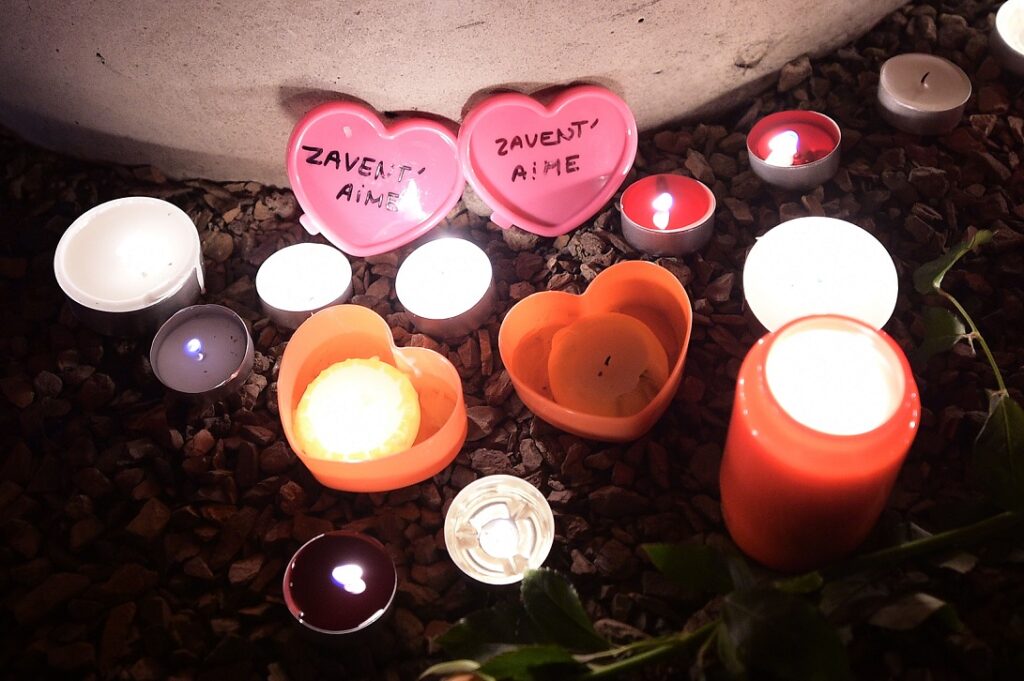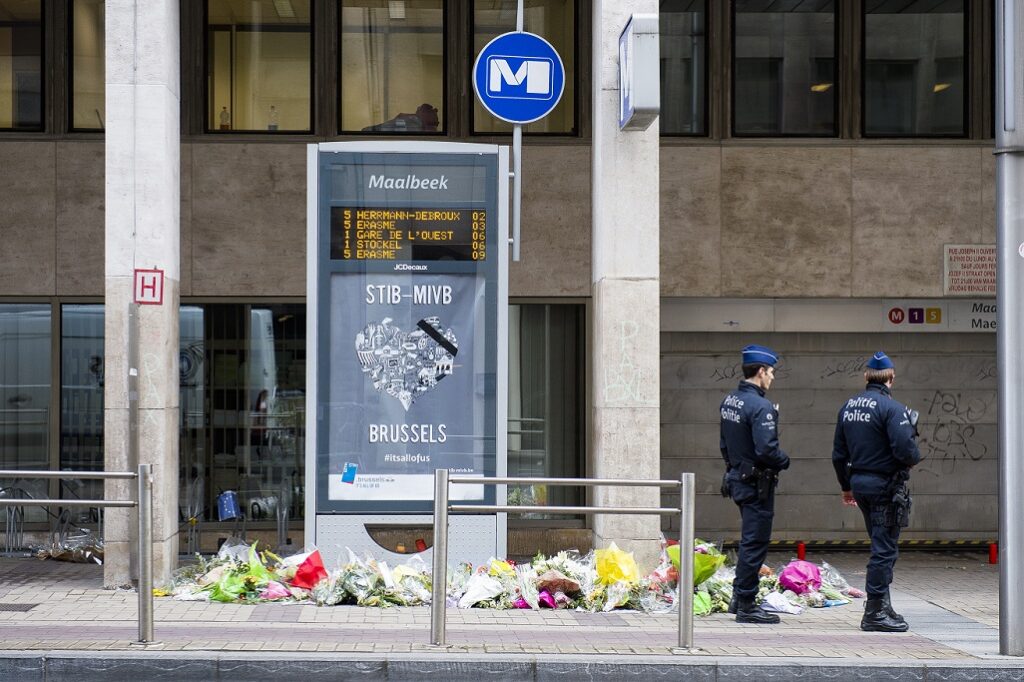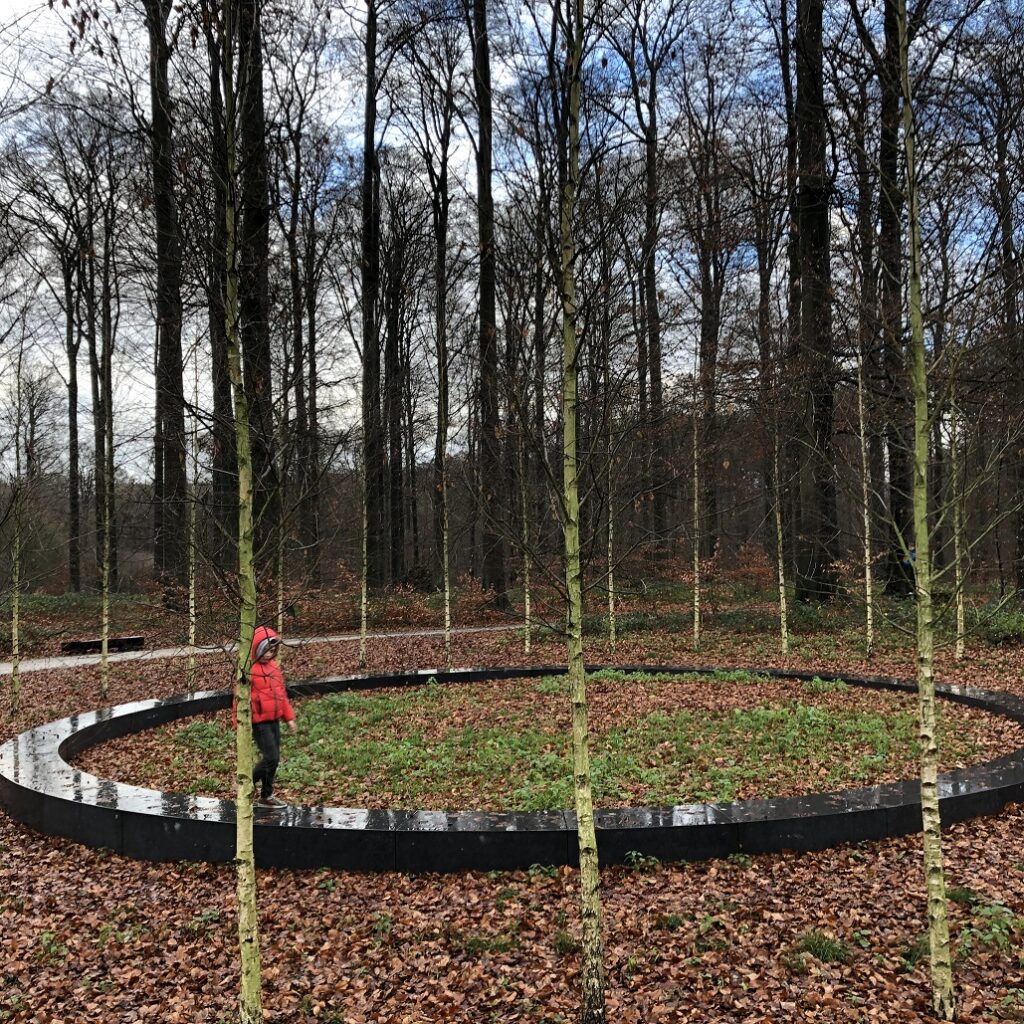It’s not easy to find the monument. It lies deep in the forest outside Brussels, away from the busy trails. A circle of 32 young birch trees was planted in a clearing in 2017 in memory of the 32 victims of two terrorist attacks in Brussels on March 22, 2016.
The Forêt de Soignes memorial was created by the landscape architect Bas Smets. The trees are equally spaced to create the impression of people standing in a circle holding hands. They surround a stone circle made of 32 blocks of polished blue limestone. There are no words on the monument. No names of the victims.
The hidden tree circle is just one of several monuments put up in memory of the worst terrorist attack in Belgian history, when bombs were detonated in the departure hall at Brussels Airport and, an hour later, in a metro train at Maelbeek station.
The victims were a random group of people. Some locals. Others passing through. A retired Belgian ambassador waiting to board a flight to the United States. A university student on his way to classes. A Swedish illustrator who lived in Brussels. A German woman flying to the US to celebrate her wedding anniversary.
When the first bombs exploded in the departure area of the Zaventem Airport in Brussels, images from the explosions were immediately published on witnesses’ social media accounts and picked up by the media. Pictures of the wounded, dead and terrified passengers running for their lives were broadcasted by almost every TV station in country.
While the news of the attacks was seemingly shaking the whole world, an hour later, a third explosion hit a rush hour metro train at Maelbeek station on the Rue de la Loi, which connects city centre with the main European Union institutions.
As emergency services rushed to the airport and the metro station, most of Brussels was paralyzed by the shock. Roads were closed, children locked in schools and residents invited to stay where they were until the further notice.
Soon, the city was eerily empty. The mood was a mix of shock, confusion and panic, like the aftermath of the September 11 attacks in New York. Another world capital had been hit by a terror attack, and no one was sure about what might happen next.

Credit: Belga
But people eventually began to gather in front of the former stock exchange on Place de la Bourse. I was down there to do a TV interview. The square had recently become car-free, making it the perfect spot to gather.
I saw people laying down flowers and toys. They were writing messages in chalk on the walls of the old stock exchange. Many looked like students who had gone down to the Bourse as an act of defiance. But there were also mothers with small children. Women wearing headscarves.
By mid-morning, the square had filled up with TV cameras broadcasting to the world. The reporters I overheard were telling a different story to the one I was seeing. They were talking about a city gripped by fear, whereas the scene on the Bourse steps was more like a spontaneous demonstration. “I refuse to be taken as a hostage by the fear of terrorists,” one student explained.
At around 6pm, then-Belgian Prime Minister Charles Michel visited the square with European Commission president Jean-Claude Juncker. Messages of support were coming in from all over. “The terrorist attacks in Brussels seem to have provoked not only solidarity among strangers but also a global wave of grief,” argued KU Leuven’s Ana Milosevic.
Paris as prelude
The Brussels attacks were a shock. But not totally unexpected. There had been other attacks by violent radicals. In 2014, a gunman shot dead four people in the lobby of the Jewish Museum in Brussels. In August 2015, a terrorist fired on passengers on a Thalys train from Amsterdam to Paris. And on November 13, 2015, three groups of Islamist terrorists carried out a series of coordinated attacks across Paris that left 130 people dead, including 90 people attending a concert at the Bataclan theatre.
The Paris attack revealed an uncomfortable truth. Most of the terror attacks were linked in some way with the Brussels commune of Molenbeek. Some of the terrorists were born in Molenbeek, others lived there. It seemed to many people that something was rotten in the capital of Europe.
The days after the Paris attack were nervous. One week later, the Belgian government responded to warnings of an imminent attack by imposing a lockdown in Brussels that shut shops, schools and public transport for several days. It was a grim foretaste of the Covid lockdown four years later.
The world was suddenly aware that Belgium was more than just a land of chocolate, beer and fries. Donald Trump, running for US President at the time, stirred the pot. In a Fox News interview on January 26, 2016, seven weeks before the attacks, he said, “I was in Brussels a long time ago, 20 years ago, so beautiful, and everything was so beautiful. It’s like living in a hellhole right now.”

Credit: Belga
Earlier, in December 2015, Politico ran an article headlined ‘Belgium is a failed state,’ in which journalist Tim King sought to explain how Belgium had become a perfect breeding ground for corruption and extremism. “Brussels’ nest of radicalism is just one of the failings of a divided, dysfunctional country,” he wrote.
Most Belgians accept their country is not perfect. Its administration could do with an overhaul. But the criticisms stung. Other countries have had terrorist attacks without being called failed states.
After the 2016 attacks, the Belgian government ramped up the security threat to its highest level and ordered 1,600 armed soldiers onto the streets of Brussels and several other cities. It was an eerie sight in a country that normally only saw armed soldiers on the streets during the National Day parades. The troops would continue patrols until September 2021.
After the emotions began to settle, many recognised that Belgium had allowed problems to fester, notably in the deprived Molenbeek. It was a cauldron of poverty, lack of jobs and the many Belgian fighters returning from Syria who had settled in the commune. The solution, according to Interior Minister Jan Jambon, was to “clean up Molenbeek.”
But Molenbeek was an easy target. Too easy, it turned out. One of the victims of the metro bomb, Loubna Lafquiri, was a Muslim mother of three who lived in Molenbeek. Her husband, Mohamed El Bachiri, launched a campaign after the attack to defuse the anger against Muslims. Imitating extremist propaganda, he published a book titled ‘Jihad d’Amour’.
Nor was Trump’s crude cliché about Brussels and Belgium representative of the US position. The former US ambassador to Belgium, Howard Gutman, published a letter in Politico in which he rejected the claim Belgium was a failed state. He pointed out that the country was ranked 14th safest in the world. “Faced with a choice between walking through parts of New York, Washington, Los Angeles or Molenbeek, the safest walk would be Molenbeek,” he wrote.
Trial of the century
All but one of the 10 terrorists directly involved in the Paris and Brussels attacks were suicide bombers who did not survive. But Salah Abdeslam, a petty criminal from Molenbeek, did. He bought some of the materials used to make the bombs and drove several of the attackers from Brussels to Paris. He should have died in the Paris attacks along with the other terrorists, but his suicide belt failed to explode, and he fled back to Belgium.
In March 2016, just days before the Brussels attacks, Belgian police tracked down Abdeslam to an apartment in Molenbeek and arrested him. Two years later, he was handed a 20-year sentence for firing on police during his arrest.
Abdeslam was then transferred to France to face trial with 19 others for their role in the 2015 attacks. That trial, which included testimony from Former French leader François Hollande, was the biggest in post-war France, involving more than 300 lawyers representing 2,500 victims and 19 defendants (although six were presumed dead). The evidence gathered by the investigation came to one million pages.
At the start of the Paris trial, in September 2021, Abdeslam made a defiant statement, describing himself as “a soldier of Islamic State”. But by the end of the nine-month trial, he was trying to persuade the court that he had not killed anyone, and he was “not a murderer or a killer.”
His defence rested on his claim that he had changed his mind and removed his suicide belt. The court wasn’t convinced. On June 30, it handed out the harshest possible sentence under French law, a full life sentence with no chance of release.

The Forêt de Soignes memorial of the 32 victims of two terrorist attacks in Brussels on March 22, 2016.
Shortly after, Abdeslam was transferred to a maximum-security cell in Ittre prison, south of Brussels. He now faces a second Belgian trial to be held in the former NATO headquarters in Evere, along with nine other suspects. The high-security courtroom had already been used for the trial of 14 people accused of helping the Paris terrorists in some way, for example by supplying weapons or hiding someone from the police.
The Brussels bombing trial, which begins in December and is expected to last six to eight months, will have a particular focus on his role in the Brussels attacks. He is not being charged with direct involvement, as he had been arrested four days before, but with the lesser charge of aiding the terrorists. The trial also involves Mohamed Abrini, named by the press as ‘the man in the hat’, who was seen leaving the airport after the bombings. Three other terrorists also face charges.
Closure
The trial is likely to bring some degree of closure for the victims. But it has left the country permanently scarred. The new reality is expressed by a monument to the victims unveiled next to the Schuman roundabout on the first anniversary of the attacks. Designed by the Brussels actor and sculptor Jean-Henri Compère, the long metal structure is titled ‘Wounded but Still Standing in Front of the Inconceivable’.
But there are other more personal reminders in the city archives. Just three days after the attacks, archivists were asked by Brussels mayor Yvan Mayeur to gather up the messages and mementoes left at the Bourse and Maelbeek metro station. The archivists took photographs and carefully preserved the handwritten messages.
You can search the archives online to look at every item saved at Bourse and Maelbeek. Some 4,000 photographs and 2,500 digitised messages are preserved. A red heart dripping blood. A Belgian flag with a broken heart. Tintin in tears.
The handwritten messages stained with rain recapture the moment of desperate sadness immediately after the attack. They are messages in many languages written by locals and tourists. They use words like peace, hope, solidarity and love. Belgium weeps for its children, one message reads.
Down in Maelbeek metro station, all traces of the bomb blast that killed 16 travellers have disappeared. The shiny tiled walls are decorated with eight faces by the Belgian illustrator Benoît, an artwork commissioned by the Brussels transport company. After the attacks, someone added a tear to one of the faces. The image rapidly spread across the Internet as a symbol of the tragedy.
The organisation Life4Brussels, which campaigns on behalf of victims of terrorism, persuaded the authorities to put up a memorial plaque with the names of the 16 passengers who died. Another memorial in a small garden outside Brussels Airport lists the 16 people who died there. Meanwhile, the 32 trees in the forest have grown a little taller.

